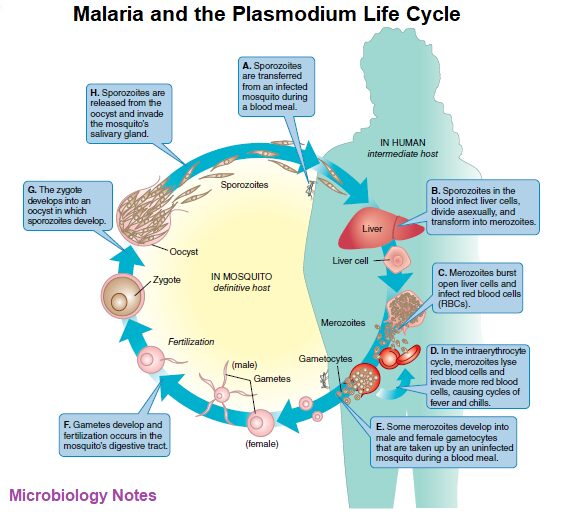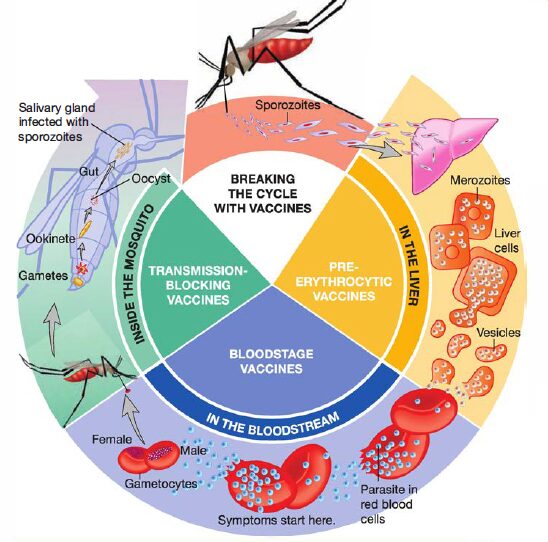Malaria: Causative Agent, Symptoms, Treatment and Prevention
What is Malaria?
- The most important human protozoal pathogens belong to the genus Plasmodium and are the causative agents of malaria.
- According to the WHO, in 2015 some 3.3 billion people, representing almost half the world’s population, were at risk of contracting malaria.
- In that year, 97 countries and territories reported cases of malaria transmission.
Causative Agent and Epidemiology of Malaria
- Human malaria is caused by five species of Plasmodium: P. falciparum, P. malariae, P. vivax, P. knowlesi, and P. ovale.
- P. falciparum is the most serious life-threatening species and the one we will focus on in this discussion.
- Malaria has been infecting humans for more than 5,000 years.
- In 2015, about 200 million people were suffering from malaria, which exacts its greatest toll in Africa.
- The WHO estimates that more than 600,000 people die from malaria every year, with younger children most susceptible (450,000 deaths) because their immune system has not yet had time to develop a degree of protective immunity.
- No infectious disease of contemporary times can claim such a dubious distinction.
- Even the United States is involved in the ongoing malaria pandemic—over 1,600 imported cases were reported in 2014.
- All plasmodial species are transmitted by the female Anopheles mosquito, the definitive host.
- Humans represent the intermediate host. The limits of transmission are primarily determined by atmosphere temperatures at which mosquitoes can sustain development.
Clinical Symptoms of Malaria
The life cycle of P. falciparum and its clinical presentation are described in FIGURE. The cycle alternates between mosquitoes and human hosts and that the parasite has three important stages: the sporozoite, the merozoite, and the gametocyte/gamete.

Sporozoite Stage
- The presence of sporozoites in the salivary glands of female mosquitoes leads to an increase in biting frequency (i.e., taking a blood meal).
- As a result, several hundred sporozoites enter the person’s bloodstream and quickly migrate to the liver.
- After a few days, the transformation of sporozoites to merozoites is completed, and up to 40,000 merozoites emerge from each infected liver cell.
Merozoite Stage
- After they are released, the free merozoites invade red blood cells (RBCs).
- Within RBCs, over a 48h-hour period each merozoite undergoes asexual reproduction to produce 16 to 32 merozoites.
- In response to a parasite biochemical signal, thousands of infected RBCs rupture simultaneously releasing the merozoites and their toxins.
- The released merozoites now infect more RBCs, and the 48-hour cycle occurs repeatedly.
- This chronic cycle of RBC infection and cell lysis called the intraerythrocyte cycle is responsible for the symptoms of malaria.
- First, there is intense cold, with shivers and chattering teeth.
- Body temperature then rises rapidly to 40°C, and the sufferer develops intense fever, headache, and delirium.
- After 2 to 3 hours, massive perspiration ends the fever stage, and the patient often falls asleep, exhausted.
- With repeated cycles of RBC infection and cell lysis, the symptoms repeat themselves.
- In a fraction of untreated individuals, the infection is not controlled and severe complications can lead to death.
- Death from malaria is due to a number of factors related to the loss of RBCs.
- Substantial anemia develops, and the hemoglobin from ruptured blood cells darkens the urine; malaria is sometimes called blackwater fever.
- Cell fragment and parasite biomass adherence accumulate on small blood vessels of then brain, kidneys, heart, liver, and other vital organs which impairs blood flow and causes clots to form.
- Heart attacks, respiratory distress, cerebral hemorrhages, and kidney failure are common.
Gametocyte/Gamete Stage
- During the merozoite stage, a proportion of the merozoites are developmentally reprogrammed to undergo a change into male and female gametocytes.
- In the peripheral circulation, the gametocytes will be ingested when an uninfected mosquito takes a blood meal.
- In the mosquito’s midgut, the gametocytes emerge as male and female gametes.
- Fertilization occurs and eventually motile sporozoites develop that pass into the salivary glands.
Treatment and Prevention of Malaria
- Since its discovery around 1640, quinine has been the mainstay for treating malaria.
- During World War II, American researchers developed the drug chloroquine, which remained an important mode of therapy until recent years, when drug resistance began emerging in Plasmodium species.
- Another drug, artemisinin, is effective in curing malaria especially when combined with other drugs to limit the development of drug resistance.
- However, the fear is that the current rise of artemisinin resistance in Plasmodium in Southeast Asia might spread to India and Africa, which would threaten their efficacy to eliminate the parasite and the disease.

- The prevention of malaria includes the use of insecticide-treated mosquito nets, indoor spraying with insecticides, better diagnostic testing for infections, and treatment with effective antimalarial medicines.
- Since 1989, mefloquine has been recommended as a preventative drug for individuals entering malaria regions of the world.
- However, serious medical side effects, including cognitive disorders, have been associated with some people taking the drug.
- Malavone is a newer antimalarial drug now recommended for malaria caused by P. falciparum.
- Experimental vaccines directed against the sporozoite or merozoite stage are being tested.
- The WHO Global Technical Strategy for Malaria 2016 has been developed with the aim of guiding and supporting regional and country programs that are trying to control and eliminate malaria.
- The goal of the malaria strategy is to lower the global malaria burden by 90% by 2030.
Reference and Sources
- https://en.m.wikipedia.org/wiki/Malaria
- http://www.gutenberg.org/files/17921/17921-h/17921-h.htm
- https://www.reuters.com/article/us-flu-diseases-sb-idUSTRE53S53X20090429
- https://apps.who.int/iris/bitstream/handle/10665/176712/9789241564991_eng.pdf?sequence=1
- https://www.who.int/bulletin/africanhealth2014/disease_threats/en/
- https://malariajournal.biomedcentral.com/articles/10.1186/s12936-020-03442-y
- https://edurev.in/course/quiz/attempt/-1_Test-Plasmodium-Lower-Animal/f0d4deef-e9bd-4bc1-bff7-61903b2d76e7
Also Read:
- Antiviral Drugs
- Anti protozoan Drugs
- what is microbiology?
- AIDS: Acquired Immune Deficiency Syndrome
- Different types of Pathways for ATP Production
- Fundamental Principle of Clinical Specimen Collection
- Mutations: Introduction, Types, Causes and Repair Mechanisms
- Syphilis: Agent, Epidemiology, Symptoms, Treatment and Prevention
- Gonorrhea: Causative Agent, Symptoms, Treatment and Prevention
- Comparison Between the Domains Bacteria, Archaea, and Eukarya
- Pneumocystis Pneumonia: Symptoms, Causative Agent, pathogenesis-treatment-and-prevention
